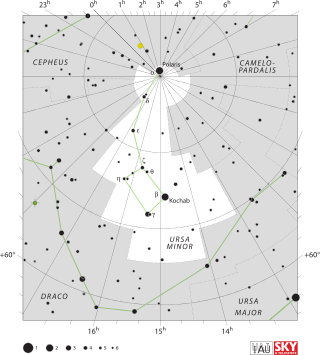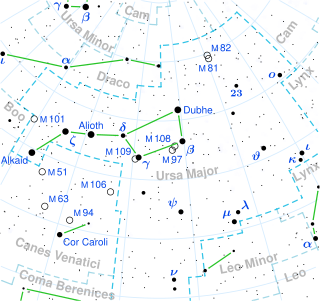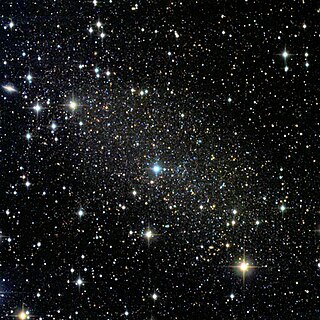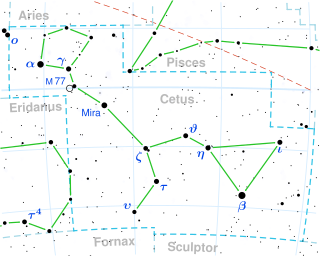
Ursa Major is a constellation in the northern sky, whose associated mythology likely dates back into prehistory. Its Latin name means "greater bear," referring to and contrasting it with nearby Ursa Minor, the lesser bear. In antiquity, it was one of the original 48 constellations listed by Ptolemy in the 2nd century AD, drawing on earlier works by Greek, Egyptian, Babylonian, and Assyrian astronomers. Today it is the third largest of the 88 modern constellations.

Ursa Minor, also known as the Little Bear, is a constellation located in the far northern sky. As with the Great Bear, the tail of the Little Bear may also be seen as the handle of a ladle, hence the North American name, Little Dipper: seven stars with four in its bowl like its partner the Big Dipper. Ursa Minor was one of the 48 constellations listed by the 2nd-century astronomer Ptolemy, and remains one of the 88 modern constellations. Ursa Minor has traditionally been important for navigation, particularly by mariners, because of Polaris being the north pole star.

Edwin Foster Coddington was an American astronomer and discoverer of astronomical objects.

Nyrölä Observatory is an amateur astronomical observatory in Finland. It is owned and operated by the astronomical association Jyväskylän Sirius ry, and located in the countryside village of Nyrölä near Jyväskylä.
Ursa is a Latin word meaning bear. Derivatives of this word are ursine or Ursini.

Alcor is a binary star system in the constellation of Ursa Major. It is the fainter companion of Mizar, the two stars forming a naked eye double in the handle of the Big Dipper asterism in Ursa Major. The two both lie about 83 light-years away from the Sun, as measured by the Hipparcos astrometry satellite.

The Ursa Minor Dwarf is a dwarf spheroidal galaxy, discovered by A.G. Wilson of the Lowell Observatory, in the United States, during the Palomar Sky Survey in 1955. It appears in the Ursa Minor constellation, and is a satellite galaxy of the Milky Way. The galaxy consists mainly of older stars and seems to house little to no ongoing star formation. Its centre is around 225,000 light years distant from Earth.

Kaivopuisto, nicknamed Kaivari in Finnish or Brunsan in Swedish, is one of the oldest and best known parks in central Helsinki, Finland, and also a neighbourhood of about 500 inhabitants where the park is located.
HD 171978 is a binary star system in the Serpens Cauda segment of the equatorial constellation of Serpens. It may be referred to by its Bright Star Catalogue identifier of HR 6993. This system is dimly visible to the naked eye with a combined apparent visual magnitude of 5.76, although is a suspected variable star of unknown type with a magnitude that has been reported to vary between 5.74 and 5.86. HD 171978 is located at a distance of approximately 537 light-years from the Sun based on parallax, and is drifting further away with a barycentric radial velocity of +11.4 km/s. It is a member of the Ursa Major Moving Group.
The Schmidt–Väisälä camera is a type of astronomical telescope intended for wide-field photographic work. It was designed by Finnish physicist Yrjö Väisälä.
The Kevola Observatory is located in Kevola in Paimio in South-Western Finland, some 35 km east from the city of Turku. The observatory is currently owned by Turun Ursa ry, a local astronomical association operating in Turku area. The buildings of the observatory include an observatory dome, a zenith observatory, and a house for recording observations.

Vartiovuori Observatory is a former observatory in Turku, Finland. The observatory, designed by Carl Ludvig Engel, was originally built for the Royal Academy of Turku. The neoclassical building was completed in 1819. The observatory is situated atop the Vartiovuori hill, and it is clearly visible from different sides of the city centre.

The Metsähovi Radio Observatory is an astronomical observatory in Finland, affiliated with the Aalto University. Its main premises are in Metsähovi, Kirkkonummi, 35 kilometers west of the university's Otaniemi campus.

Ursa Astronomical Association is the largest astronomical association in Finland. Ursa was founded on 2 November 1921. Founding members include a renowned Finnish astronomer Yrjö Väisälä. In 1926 Ursa established the Ursa Observatory in Kaivopuisto district of Helsinki. In 2007 the Tähtikallio Observatory & Education Center was established in Artjärvi, its current equipment includes an Astrofox 36" Folded Newtonian Open tube telescope, an Alluna 16" Ritchey-Chrétien telescope, a Meade 16" LX200GPS Schmidt-Cassegrain telescope, a Sky-Watcher ED 120mm refractor telescope fitted with a Baader AstroSolar Solar Filter and a piggybacked Coronado SolarMax 40 H-Alpha telescope. Ursa's primary functions include advancing amateur astronomy and astronomical education. They have also published a magazine Tähdet ja avaruus since 1971. Anyone can join Ursa for an annual fee.

Iso-Heikkilä Observatory is an amateur astronomical observatory used by a local amateur astronomical association, Turun Ursa ry in the Iso-Heikkilä district of Turku, Finland.
Tähdet ja avaruus is a Finnish science magazine which publishes recent developments, news and interviews in astronomy, space technology, cosmology and amateur astronomy. It is the largest circulation astronomy magazine in northern Europe.

Helsinki University Observatory housed the Department of Astronomy at the University of Helsinki, south Finland until end of 2009. It is now an astronomy-themed visitor centre and museum.

ν Ceti, Latinized as Nu Ceti, is a binary star system in the equatorial constellation of Cetus. It is visible to the naked eye as a faint point of light with a combined apparent visual magnitude of 4.86. The system is located approximately 340 light years distant from the Sun, based on parallax, and is drifting further away with a radial velocity of 4.8 km/s. Nu Ceti is believed to be part of the Ursa Major stream of co-moving stars.

Fundamental Astronomy (1984–2017) is an astronomy textbook by Finnish author Hannu Karttunen of University of Turku; Pekka Kröger and Heikki Oja of University of Helsinki; Markku Poutanen of Finnish Geodetic Institute; and Karl Johan Donner of University of Helsinki. The first edition was published in Finnish by Ursa, Helsinki, 1984, and later published in English by Springer. The 6th edition was published in 2017. It contains 548 pages and is illustrated with more than 419 images, including 34 color plates. There are many pages on the solar system, the Milky Way, galaxies, and cosmology.

The habitability of neutron star systems means assessing and surveying whether life is possible on planets and moons orbiting a neutron star.
















